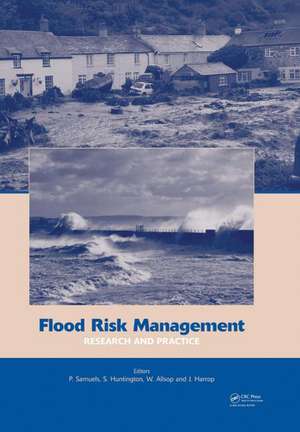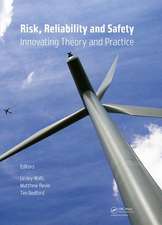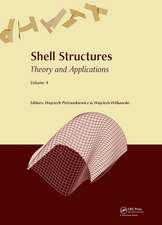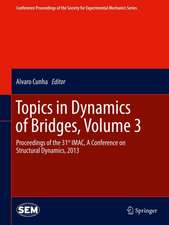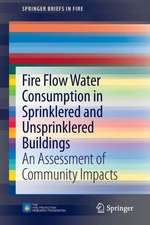Flood Risk Management: Research and Practice: Extended Abstracts Volume (332 pages) + full paper CD-ROM (1772 pages)
Editat de Paul Samuels, Stephen Huntington, William Allsop, Jackie Harropen Limba Engleză Hardback – oct 2008
Flood Risk Management: Research and Practice includes about 200 contributions from the international conference FLOODrisk 2008 (Oxford, UK, 30 September – 2 October 2008). FLOODrisk 2008 was an initiative of the FLOODsite research project on Integrated Flood Risk Analysis and Management Methodologies. FLOODsite was a major “Integrated Project” in the European Commission Sixth Framework Programme; contract number GOCE-CT-2004-505420. The conference provided a forum for leading researchers, flood risk managers, policy makers and practitioners from government, commercial and research organisations to gain an overview of advances in this important subject. Flood risk management practice crosses several professions and disciplines and these are represented in the breadth of the scope of the conference and these proceedings. The conference covered all aspects of flood risk: the causes of floods, their impacts on people, property and the environment, and portfolios of risk management measuresm, while the principal themes included: climate change, estimation of extremes, flash floods, flood forecasting and warning, inundation modelling, systems analysis, uncertainty, international programmes, flood defence infrastructure and assets, environmental impacts, human and social impacts, vulnerability and resilience, risk sharing, equity and social justice, and, civil contingency planning and emergency management.
Flood Risk Management: Research and Practice will be of interest to an international readership, ranging from authorities, consultants and engineers involved in flood management; researchers, post graduate lecturers and students, to policy makers, particularly at national level.
Preț: 2523.11 lei
Preț vechi: 3555.20 lei
-29% Nou
Puncte Express: 3785
Preț estimativ în valută:
482.95€ • 524.77$ • 405.94£
482.95€ • 524.77$ • 405.94£
Carte tipărită la comandă
Livrare economică 21 aprilie-05 mai
Preluare comenzi: 021 569.72.76
Specificații
ISBN-13: 9780415485074
ISBN-10: 041548507X
Pagini: 332
Dimensiuni: 174 x 246 x 23 mm
Greutate: 0.75 kg
Ediția:New.
Editura: CRC Press
Colecția CRC Press
ISBN-10: 041548507X
Pagini: 332
Dimensiuni: 174 x 246 x 23 mm
Greutate: 0.75 kg
Ediția:New.
Editura: CRC Press
Colecția CRC Press
Notă biografică
Paul Samuels, Stephen Huntington, William Allsop, Jackie Harrop
Cuprins
Keynote Presentation; Coastal flooding: A view from a practical Dutchman on present and future strategies; Technical Presentations; Inundation modelling; Recent development and application of a rapid flood spreading method; Hydrodynamic modelling and risk analysis in RAMFLOOD project; Testing and application of a practical new 2D hydrodynamic model; Floods study through coupled numerical modeling of 2D surface and sewage network flows; Modelling of flooding and analysis of pluvial flood risk – demo case of UK catchment; An integrated approach to modelling surface water flood risk in urban areas; Estimation of flood inundation probabilities using global hazard indexes based on hydrodynamic variables; Flood modeling for risk evaluation – a MIKE FLOOD vs. SOBEK 1D2D benchmark study; Comparing forecast skill of inundation models of differing complexity: The case of Upton upon Severn; Comparison of varying complexity numerical models for the prediction of flood inundation in Greenwich, UK; Fast 2D floodplain modeling using computer game technology; Grid resolution dependency in inundation modelling: A case study; 2D overland flow modelling using fine scale DEM with manageable runtimes; Detailed 2D flow simulations as an onset for evaluating socio-economic impacts of floods; Ensemble Prediction of Inundation Risk and Uncertainty arising from Scour (EPIRUS): An overview; Flood risk assessment using broad scale two-dimensional hydraulic modelling – a case study from Penrith, Australia; Modelling and analysis of river flood impacts on sewage networks in urban areas; Coastal flood risk modelling in a data rich world; A multi-scale modelling procedure to quantify effects of upland land management on flood risk; Updating flood maps using 2D models in Italy: A case study; Real-time validation of a digital flood-inundation model: A case-study from Lakes Entrance, Victoria, Australia; Dispelling the myths of urban flood inundation modelling; Flood risk in urban areas caused by levee breaching; RISK-EOS flood risk analysis service for Europe; Flood inundation modelling: Model choice and application; Risk maps of torrential rainstorms; Decision Support System for flood forecasting and risk mitigation in the context of Romanian water sector; Developing a rapid mapping and monitoring service for flood management using remote sensing techniques; A framework for Decision Support Systems for flood event management – application to the Thames and the Schelde Estuaries; Modelling tsunami overtopping of a sea defence by shallow-water Boussinesq, VOF and SPH methods; Modelling the 2005 Carlisle flood event using LISFLOOD-FP and TRENT; Experience of 1D and 2D flood modelling in Australia – a guide to model selection based on channel and floodplain characteristics; Computationally efficient flood water level prediction (with uncertainty); Optimization of 2D flood models by semi-automated incorporation of flood diverting landscape elements; Understanding the runoff response of the Ourthe catchment using spatial and temporal characteristics of the storm field obtained by radar; The importance of spill conceptualizations and head loss coefficients in a quasi two-dimensional approach for river inundation modelling; Inundation scenario development for damage evaluation in polder areas; System analysis; Importance of river system behaviour in assessing flood risk; Development and evaluation of an integrated hydrological modelling tool for the Water Framework Directive and Floods Directive; A comparison of modelling methods for urban flood risk assessment; Coastal flood risk analysis driven by climatic and coastal morphological modelling; Micro-scale analysis of flood risk at the German Bight Coast; Flood hazard mapping for coastal storms in the Delta Ebro; RAMWASS Decision Support System (DSS) for the risk assessment of water-sediment-soil systems – application of a DSS prototype to a test site in the lower part of the Elbe river valley, Germany; Radar based nowcasting of rainfall events – analysis and assessment of a one-year continuum; On the quality of Pareto calibration solutions of conceptual rainfall-runoff models; Model reuse and management in flood risk modelling; International programmes; Flood Risk from Extreme Events (FREE): A NERC-directed research programme – understanding the science of flooding; Advances in flood risk management from the FLOODsite project; The Tyndall Centre Coastal Simulator and Interface (CoastS); The social impacts of flooding in Scotland: A national and local analysis; The Flood Risk Management Research Consortium (FRMRC); EIB financing for flood risk mitigation; One nation, one policy, one program flood risk management; Toward a transnational perspective on flood-related research in Europe – experiences from the CRUE ERA-Net; Infrastructure and assets; Hazards from wave overtopping; Time-dependent reliability analysis of anchored sheet pile walls; Analysis of tsunami hazards by modelling tsunami wave effects; Influence of management and maintenance on erosive impact of wave overtopping on grass covered slopes of dikes; Tests; Sea wall or sea front? Looking at engineering for Flood and Coastal Erosion Risk Management through different eyes; The new turner contemporary gallery – an example of an urban coastal flood risk assessment; EurOtop – overtopping and methods for assessing discharge; Reliable prediction of wave overtopping volumes using Bayesian neural networks; Calculation of fragility curves for flood defence assets; Reservoir flood risk in the UK; Modelling breach initiation and growth; A probabilistic failure model for large embankment dams; Reliability analysis of flood defence structures and systems in Europe; PCRIVER—software for probability based flood protection; Representing fragility of flood and coastal defences: Getting into the detail; Application of 3D serious games in levee inspection education; Strategic appraisal of flood risk management options over extended timescales: Combining scenario analysis with optimization; Embedding new science into practice – lessons from the development and application of a Performance-based asset management system; Study of flood embankment behaviour induced by air entrapment; Assessment of flood retention in polders using an interlinked one-two-dimensional hydraulic model; Fragility curve calculation for technical flood protection measures by the Monte Carlo analysis; Application of GMS system in the Czech Republic – practical use of IMPACT, FLOODSite and GEMSTONE projects outcomes; Failure modes and mechanisms for flood defence structures; Non-structural approaches (CRUE project); Flood risk map perception through experimental graphic semiology; Quantifying the benefits of non-structural flood risk management measures; Efficiency of non-structural flood mitigation measures: “room for the river” and “retaining water in the landscape”; Flood risk reduction by PReserving and restOring river FLOODPLAINs – PRO_FLOODPLAIN; The use of non structural measures for reducing the flood risk in small urban catchments; EWASE—Early Warning Systems Efficiency: Evaluation of flood forecast reliability; Flood risk assessment in an Austrian municipality comprising the evaluation of effectiveness and efficiency of flood mitigation measures; EWASE—Early Warning Systems Efficiency – risk assessment and efficiency analysis; Flood risk management strategies in European Member States considering structural and non-structural measures; Long term planning, integrated portfolios & spatial planning; The OpenMI-LIFE project – putting integrated modelling into practice in flood management; A method for developing long-term strategies for flood risk management; Flood Risk Mapping, using spatially based Systems Engineering; Finding a long term solution to flooding in Oxford: The challenges faced; Risk analysis and decision-making for optimal flood protection level in urban river management; An integrated risk-based multi criteria decision-support system for flood protection measures in riversheds—REISE; Integrated methodologies for flood risk management practice in European pilot sites; Underpinning flood risk management: A digital terrain model for the 21 st century; Integrated land and water management in floodplains in England; Putting people and places at the centre: Improving institutional and social responses to flooding; Delivering Integrated Urban Drainage – current obstacles and a proposed SUDS planning support tool; Strategic planning for long-term Flood Risk Management – findings from case studies in Dresden and London; Extreme flood events & flood management strategy at the Slovak-Austrian part of the Morava river basin; Using non-structural responses to better manage flood risk in Glasgow; Vulnerability and resilience, human and social impacts; The policy preferences of citizens, scientists and policy makers; Analysis of the human and social impacts of flooding in Carlisle 2005 and Hull 2007; Institutional and social responses to flooding from a resilience perspective; Flood, vulnerability and resilience: A real-time study of local recovery following the floods of June 2007 in Hull; Increasing resilience to storm surge flooding: Risks, social networks and local champions; A new model to estimate risk to life for European flood events; Towards flood risk management with the people at risk: From scientific analysis to practice recommendations (and back); Use of human dimensions factors in the United States and European Union; Double whammy? Are the most at risk the least aware? A study of environmental justice and awareness of flood risk in England and Wales; Improving public safety in the United States – from Federal protection to shared flood risk reduction; Evaluating the benefits and limitations of property based flood resistance and resilience – a UK perspective; Flood risk management: Experiences from the Scheldt Estuary case study; Overcoming the barriers to household-level adaptation to flood risk; Human vulnerability to flash floods: Addressing physical exposure and behavioural questions; Assessment of extremes; Estimating extremes in a flood risk context. The FLOODsite approach; Inter-site dependence in extremes: Unlocking extra information; The Flood Estimation Handbook and UK practice: Past, present and future; Extreme precipitation mapping for flood risk assessment in ungauged basins of the upper Hron River basin in Slovakia; River flood frequency approaches for ungauged sites; Non-stationary point process models for extreme storm surges; Bayesian non-parametric quantile regression using splines for modelling wave heights; Multiscale probabilistic risk assessment; Improving the understanding of the risk from groundwater flooding in the UK; Radar observation of storm rainfall for flash-flood forecasting; Climate change impact on hydrological extremes along rivers in Belgium; Uncertainties in 1D flood level modeling: Stochastic analysis of upstream discharge and friction parameter influence; Civil contingency, emergency planning, flood event management; Reservoir safety in England and Wales – reducing risk, safeguarding people; A comparison of evacuation models for flood event management – application on the Schelde and Thames Estuaries; Hydrodynamic and loss of life modelling for the 1953 Canvey Island flood; Short-range plain flood forecasting and risk management in the Bavarian Danube basin; Fast access to ASAR imagery for rapid mapping of flood events; Benefits of 2D modelling approach for urban flood management; Computer modelling of hydrodynamic conditions on the Lower Kuban under various scenarios and definition of limiting values of releases from the Krasnodar, Shapsugsky and Varnavinsky hydrounits for prevention of flooding; Flood warning in the UK: Shifting the focus; New approaches to ex-post evaluation of risk reduction measures: The example of flood proofing in Dresden, Germany; Dilemmas in land use planning in flood prone areas; Emergency management of flood events in Alpine catchments; Flood forecasting and warning; Flood warning in smaller catchments; A prototype of road warning system in flood prone area; Snow and glacier melt – a distributed energy balance model within a flood forecasting system; Analysis of weather radar and rain gauges for flood forecasting; Integration of hydrological information and knowledge management for rapid decision-making within European flood warning centres; Local warning systems in Slovakia; The provision of site specific flood warnings using wireless sensor networks; Managing flood risk in Bristol, UK – a fluvial & tidal combined forecasting challenge; Off-line flood warning concept for railways; Satellite observation of storm rainfall for flash-flood forecasting in small and medium-size basins; Potential warning services for groundwater and pluvial flooding; Data assimilation and adaptive real-time forecasting of water levels in the river Eden catchment, UK; To which extent do rainfall estimation uncertainties limit the accuracy of flash flood forecasts?; Advances in radar-based flood warning systems. The EHIMI system and the experience in the Besòs flash-flood pilot basin; Flash flood risk management: Advances in hydrological forecasting and warning; Decision support system for flood forecasting in the Guadalquivir river basin; Operational flash flood forecasting chain using hydrological and pluviometric precursors; Online updating procedures for flood forecasting with a continuous rainfall-runoff-model; GIS technology in water resources parameter extraction in flood forecasting; Combining weather radar and raingauge data for hydrologic applications; The worst North Sea storm surge for 50 years: Performance of the forecasting system and implications for decision makers; Probabilistic coastal flood forecasting; Coastal flood inundation modelling for North Sea lowlands; New north east of England tidal flood forecasting system; Impact of extreme waves and water levels in the south Baltic Sea; Bayesian rainfall thresholds for flash flood guidance; Environmental impacts, morphology & sediments; Assessment of hydraulic, economic and ecological impacts of flood polder management – a case study from the Elbe River, Germany; Development of estuary morphology models; A GIS-based risk assessment methodology for flood pollutants; Environmental impact of flash floods in Hungary; Predicting beach morphology as part of flood risk assessment; Alkborough scheme reduces extreme water levels in the Humber Estuary and creates new habitat; Managing coastal change: Walberswick to Dunwich; Uncertainties in the parameterisation of rainfall-runoff-models to quantify land-use effects in flood risk assessment; Impact of the barrage construction on the hydrodynamic process in the severn estuary using a 2D finite volume model; Risk sharing, equity and social justice; From knowledge management to prevention strategies: The example of the tools developed by French insurers; What?s ‘fair? about flood and coastal erosion risk management? A case study evaluation of policies and attitudes in England; Flood risk perceptions in the Dutch province of Zeeland: Does the public still support current policies?; A partnership approach – public flood risk management and private insurance; The international teaching module FLOODmaster – an integrated part of a European educational platform on flood risk management; Decision support for strategic flood risk planning – a generic conceptual model; Who benefits from flood management policies?; Uncertainty; Long term planning – robust strategic decision making in the face of gross uncertainty (tools and application to the Thames); Anticipatory water management for advanced flood control; Staged uncertainty and sensitivity analysis within flood risk analysis; Assessing uncertainty in rainfall-runoff models: Application of data-driven models; Flash floods; European flash floods data collation and analysis; Representative flash flood events in Romania Case studies; Changes in flooding pattern after dam construction in Zadorra river (Spain): The events of October 1953 and February 2003; Post flash flood field investigations and analyses: Proposal of a methodology and illustrations of its application; Hydrological and hydraulic analysis of the flash flood event on 25 October 2007 in North-Eastern part of Sicily, Italy; The day roads became rivers: A GIS-based assessment of flash floods in Worcester; Risk and economic assessments; Flood risk mapping of Austrian railway lines; Correlation in time and space: Economic assessment of flood risk with the Risk Management Solutions (RMS) UK River Flood Model; A case study of the Thames Gateway: Flood risk, planning policy and insurance loss potential; Integration of accurate 2D inundation modelling, vector land use database and economic damage evaluation; Planning for flood damages reduction: A case study; High resolution inundation modelling as part of a multi-hazard loss modelling tool; Estimation of flood losses due to business interruption; Residential flood losses in Perth, Western Australia; A multicriteria flood risk assessment and mapping approach; New developments in maximizing flood warning response and benefit strategies; Development of a damage and casualties tool for river floods in northern Thailand; Synthetic water level building damage relationships for GIS-supported flood vulnerability modeling of residential properties; Impacts of the summer 2007 floods on agriculture in England; Climate change; Simulating flood-peak probability in the Rhine basin and the effect of climate change; Climate changes in extreme precipitation events in the Elbe catchment of Saxony; A methodology for adapting local drainage to climate change; Exploring and evaluating futures of riverine flood risk systems – the example of the Elbe River
Descriere
Based on the work of leading researchers, this book provides an overview of advances in this important subject. It covers all aspects of flood risk including the causes of floods; their impacts on people, property and the environment; and portfolios of risk management measurement. Additional topics include climate change, estimation of extremes, flash floods, flood forecasting and warning, inundation modeling, systems analysis, uncertainty, international programs, and flood defense infrastructure and assets. The book also examines environmental, human, and social impacts; vulnerability and resilience; risk sharing; and civil contingency planning and emergency management.
